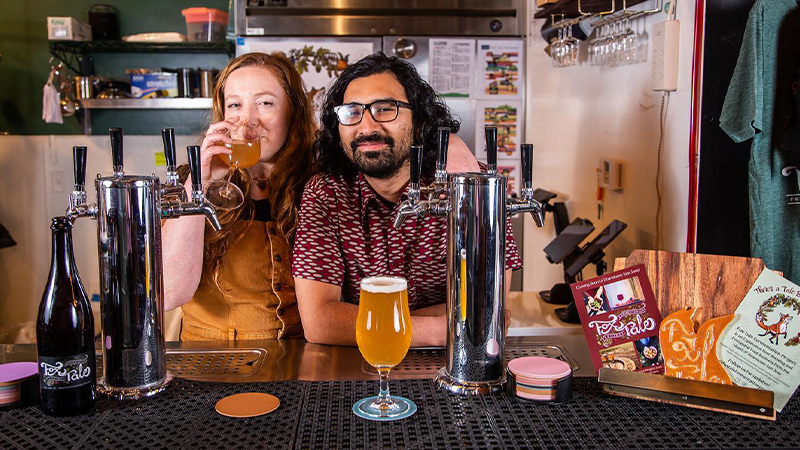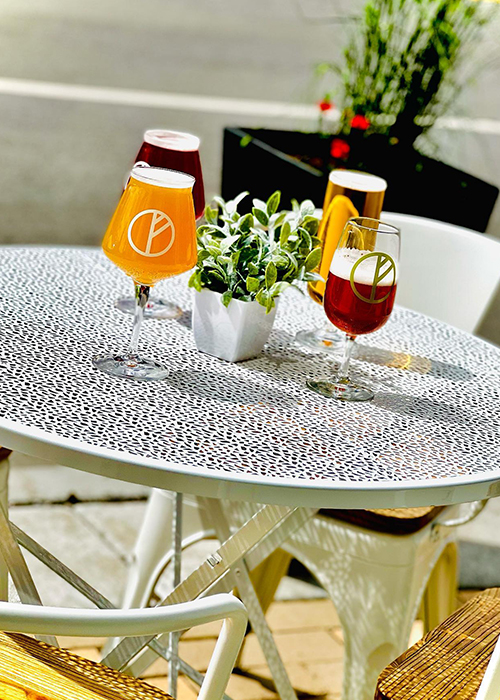At first glance, Tyler Davis is easy to recognize as a brewer: He has a typical brewer’s beard, a brewer’s baseball cap, and a brewer’s gregarious demeanor, backed up by a résumé that includes time at some of Chicago’s most popular beer makers. But after years at Lagunitas Brewing Company and Revolution Brewing, Davis chose a different definition when he opened his own place in late 2021. Instead of a “beer company,” “brewing company,” or “brewery,” Davis calls Duneyrr, his new beverage business, an “artisan fermenta project.”
That choice is inspired by the ingredients he’s using, which include the grains that are commonly used to make beer, as well as grapes, apples, and other fruits, all “co-fermented” into unusual beverages that defy traditional categories.
“I could tell you it’s a beer, but you’d be like, ‘No, it’s not,’” he says. “If I say ‘brewery,’ people are going to say, ‘This isn’t beer.’”
Neither brewery nor winery, neither cider house nor meadery, Duneyrr and other hybrid producers are part of a new trend that embraces multiple possibilities for what modern fermented beverages can be — and what we call the places that make them. Avoiding traditional terms like “brewery” or “beer company,” these new producers are instead calling themselves something else.
Many of the drinks they’re making are similarly hard to pigeonhole, like Duneyrr’s Nysnö, a “rosé” wild ale made with cider apples, wildflower honey, and lingonberries; or Sauvÿn, its sour hybrid ale with Sauvignon Blanc grape must and passionfruit. Despite the grapes and apples, they’re not what most of us think of as wines or ciders. But they’re definitely not hazy IPAs, either.
For Davis, avoiding the word “brewery” offered some clear advantages. To start, his customers are more open-minded.
“Having the Duneyrr ‘Fermenta Project,’ you kinda don’t know what to expect, and it’s easier for all of us to curate the experience more,” he says. “There’s way more sense of wonder as well, too, that a lot of people are getting. They’re just like, ‘What are you doing? What’s going on here? How are you doing this?’ It gives you the spotlight to describe what the entire concept is. Having that freedom is incredibly liberating.”
In addition, not calling Duneyrr a brewery leaves the future wide open.
“I didn’t want to bind myself to just doing beers,” Davis says. “I know that I eventually want to have an urban winery here, and then doing co-fermentation of ciders and all of that. I wanted a general overlapping definition. Once I start doing wine and cider hybrids, mead hybrids, I wanted the fermentations to be the main focus of it. All these things, they won’t have a ton of definitions to them, but they all will be fermented.”
Cutting-Edge Projects
Duneyrr might be alone in calling itself a “fermenta” project — Davis says he chose that word instead of “fermentation” simply because it had a better flow to it — but many other cutting-edge producers are flying under a similar flag, including Fox Tale Fermentation Project and Soquel Fermentation Project.

Other makers have adopted different terms, though often with the same two goals of avoiding categorization and shifting consumer focus. In San Diego, the cider, hard kombucha, mead, and fruit-wine producer FruitCraft describes itself as a “fermentery,” a word it shares with Fermentery Form in Philadelphia. On a small farm outside of Münster, Germany, what was once known as Brauerei Jan Kemker changed its name to Kemker Kultuur in 2020. Owner Jan Kemker says that the shift allowed his brewery to emphasize three important types of culture: agriculture, eating and drinking culture, and the house yeast culture that he uses to ferment his beers and ciders, many of which have a strong winemaking influence.
A similar reasoning stands behind Antidoot, a hybrid producer that only started selling its products to the public shortly before it was named the best brewery in Belgium in 2019, even though its name doesn’t include the words for brewery or beer in French, Flemish, or even English. A former professor of philosophy, co-founder Tom Jacobs thought hard about the correct terminology for a producer of beer, wine, and cider, as well as blends that include all three at the same time. The result? Antidoot Wilde Fermenten, or “wild fermentations.”
“Organically, it became one thing,” he says. “We stopped making the strict distinction between, say, fermenting wort, fermenting apple juice, or fermenting grapes. We thought it’s a bit limiting for people. We also wanted to reach out to an audience that was broader than the typical beer world.”
To that end, Antidoot avoids identifying its products with the names of beer styles. Instead, the emphasis is simply on how they were made.
“If you see a beer and it says ‘saison’ or ‘porter’ or ‘IPA,’ they have a very limiting concept,” Jacobs says. “And the problem is, if you drink it, you are immediately comparing what you know about the concept, so there’s less open-mindedness in tasting. That’s why, for all the beers, we don’t use any category.”
In the case of Antidoot’s L’Ambigu, the label merely identifies the drink’s color as amber, before launching into a short free-verse poem about language, meaning, ambiguity, and form.
“We always start with a poem, because we want to create a kind of mindset and trigger imagination,” Jacobs says. “Then we describe just what we did.” For L’Ambigu, the label says: “In late summer 2018, we macerated the skins of our white grape varieties (Cabernet Franc, Cal 6/04, and Gewürztraminer) in a beer brewed seven months earlier. After a month of skin maceration, we took out the skins, and aged the beer for seven more months. Bottled April 2019.”
The same thinking behind Antidoot’s name and bottle labels also extends to its social media. In all three, the goal is to get drinkers to think about the process of making drinks, rather than the drinks themselves.
“We want to bring people more to the inside of production,” Jacobs says. “If we show things on Instagram, we don’t want to use it as a kind of publicity forum for commodities. We want to show what we do, how we do it, where we do it.”
Separating Product Lines
Even for traditional breweries, having a “fermentation project” name can help differentiate a product line, especially if it comes with its own branding.
In the Melbourne suburb of Footscray, Australia, the seven-year-old craft brewery Hop Nation turns out a fleet of hazy pale ales, IPAs, pilsners, oatmeal stouts, and other contemporary styles. But when owners Sam Hambour and Duncan Gibson started making mixed-fermentation, fruit-forward brews that reflected their original training as winemakers, they decided to put those drinks out under a different brand, Site Fermentation Project.
“Site Fermentation Project, for us, has always just been about experimentation,” Gibson says. “Obviously, barrel work and using mixed fermentation is a way to get back into doing some of what we used to do and enjoyed, and using the different fruit elements. It was a way for us to reconnect with the techniques that we learned when we were winemakers.”
To keep the product lines defined and separate, Gibson and Hambour had Site Fermentation Project rebranded last November, moving to bottles instead of cans and changing the design.

“We really wanted to stand it apart from our hoppy clean beers and show that we were angling for something that’s a bit more serious and a bit more food-orientated,” Gibson says. “So we put it into 375-milliliter Champagne bottles and then redid our labels to make them less quirky and crafty and more serious.”
The Legal Matters Matter
While cutting-edge brewers might eschew the words “brewery” and “beer,” Johnny Law has his own demands. No matter how they might style themselves, many new hybrid producers are still legally classified as brewers, turning out what are still considered beers for tax and regulatory purposes.
In conversations with his customers, Davis tries to avoid defining Duneyrr’s cutting-edge drinks too closely, leaving things open to the drinker’s interpretation. But Duneyrr’s packaged products are subject to the requirements of the TTB — the U.S. Department of the Treasury’s Alcohol and Tobacco Tax and Trade Bureau.
“I just call them hybrids, ’cause that’s the easiest way for people to understand. It leaves it loose enough, and you can do a definition like ‘beer-cider hybrid,’ or ‘wine-beer hybrid,’” Davis says. “Legally, on the label, through the TTB and all that crazy stuff, I have to say ‘hybrid ale.’”
Hybrid drinks and breweries that don’t call themselves breweries might feel like the avant-garde of contemporary drinks culture, but if enough producers join them, they could well become the mainstream. As such, there might be new, as-yet-unknown terms for such makers, as well as for the drinks they’re making.
For Davis, the experimentation at Duneyrr is only the beginning. His voice gets louder and faster when he starts talking about the possibilities of hybrid drinks, working with local fruit, malt, and other products to come up with new styles that haven’t been invented yet.
“You could focus on that for years, because there’s endless amounts of grains and farms and maltsters and all of that — God, the honeys! It really opens up the entire thing,” he says. “The more that people start experimenting with fermenting and co-fermenting, the brewery itself is being more open by not calling itself a brewery. I think it’s definitely going to become more of a trend.”
This story is a part of VP Pro, our free platform and newsletter for drinks industry professionals, covering wine, beer, liquor, and beyond. Sign up for VP Pro now!
